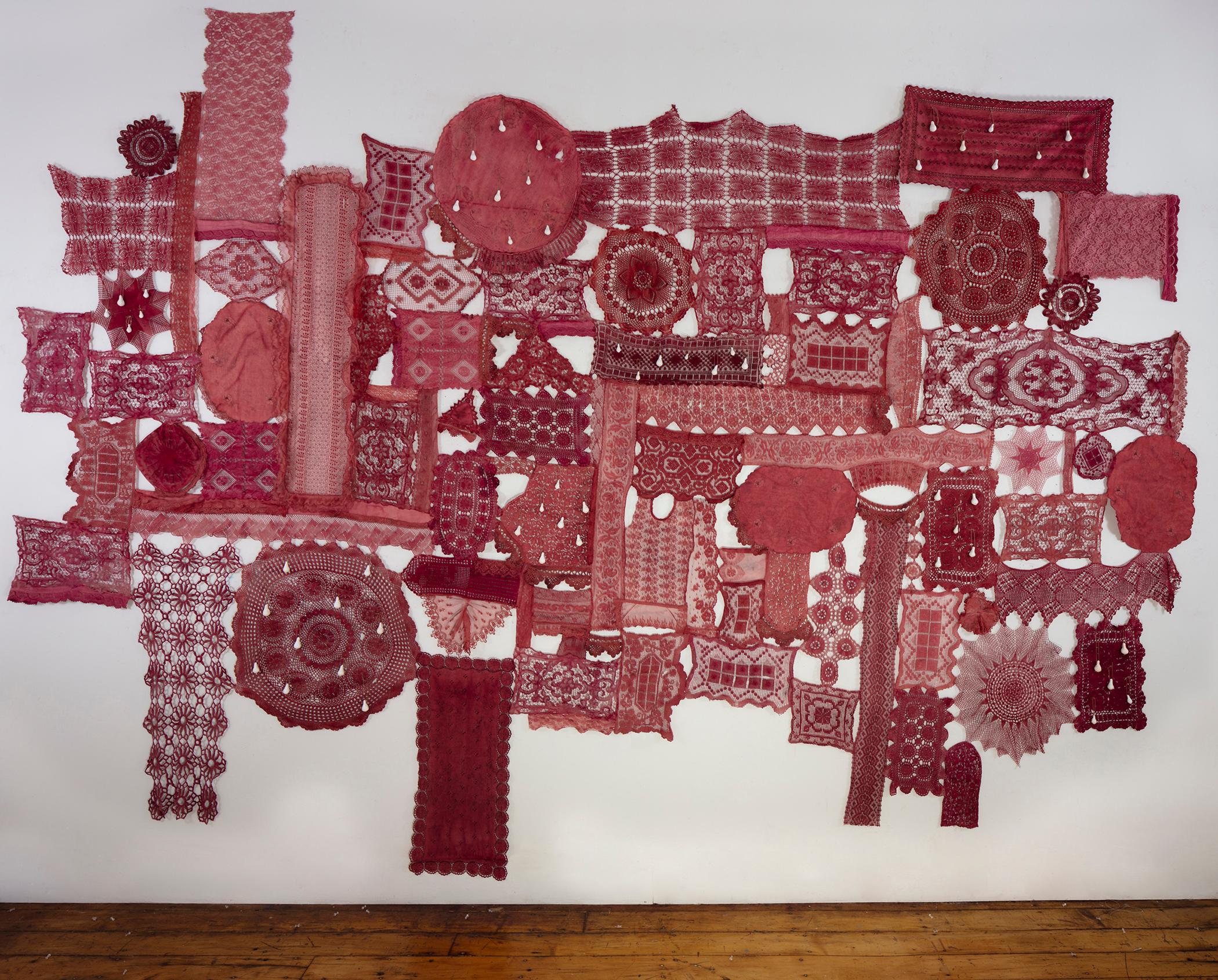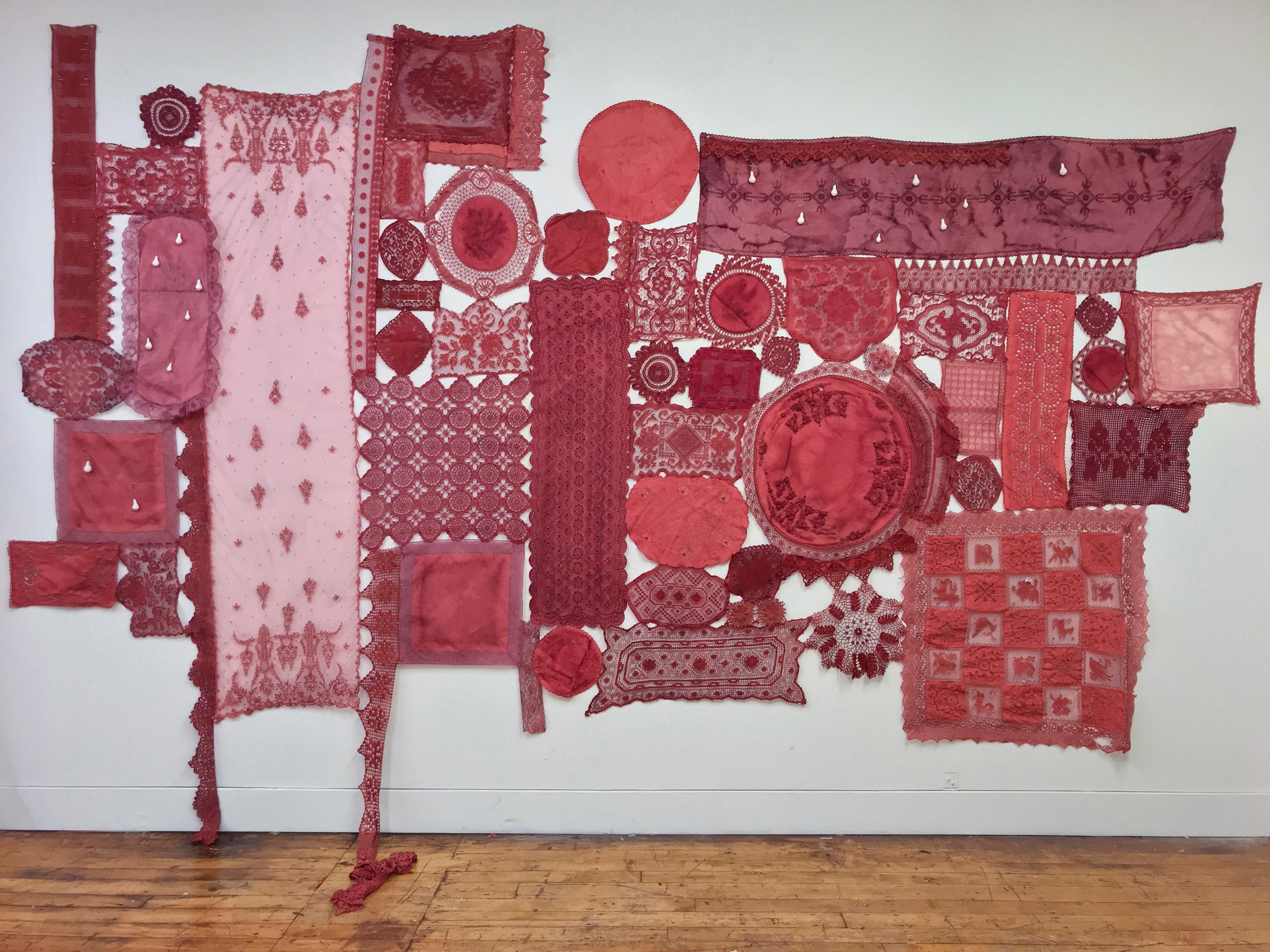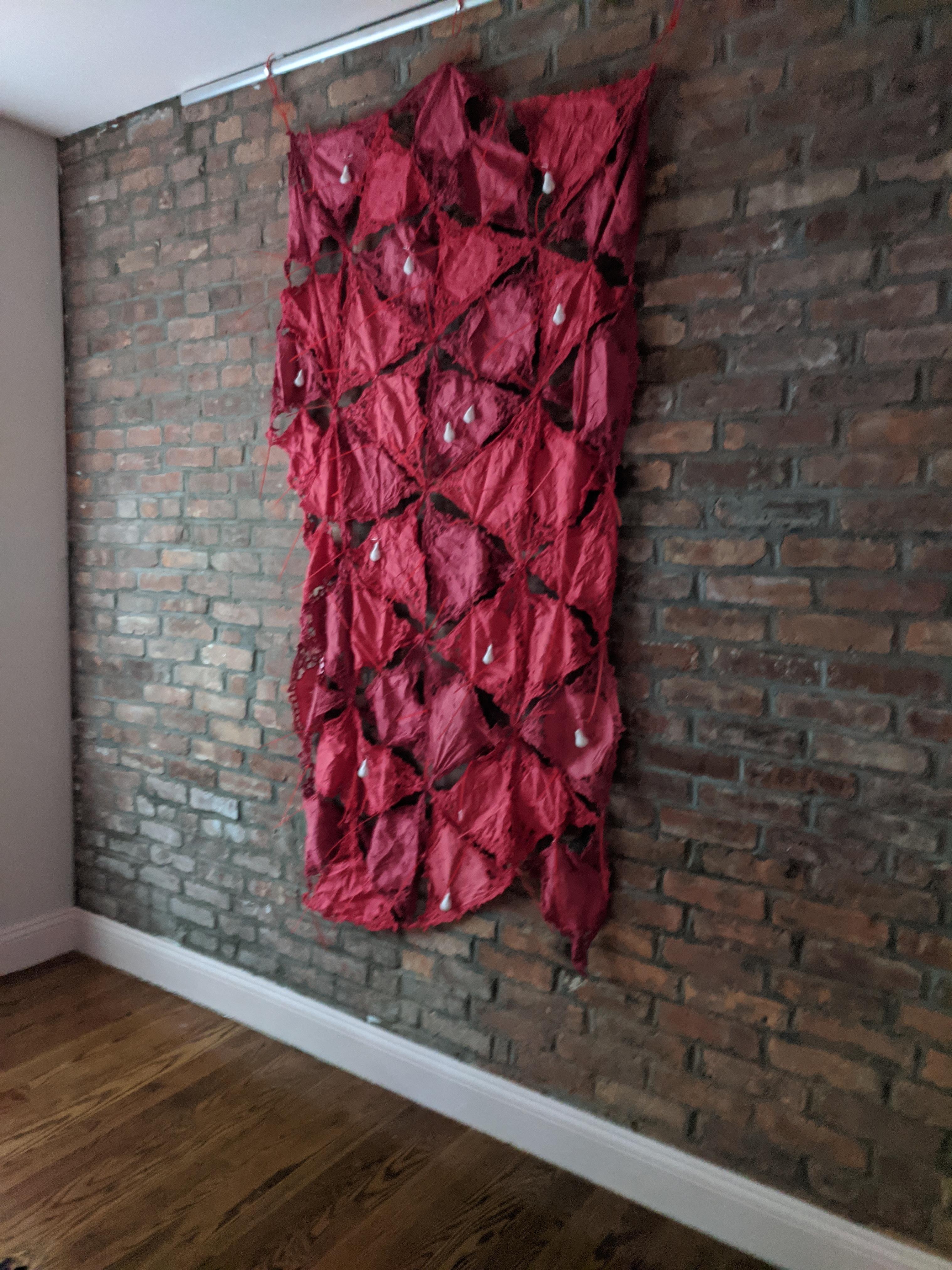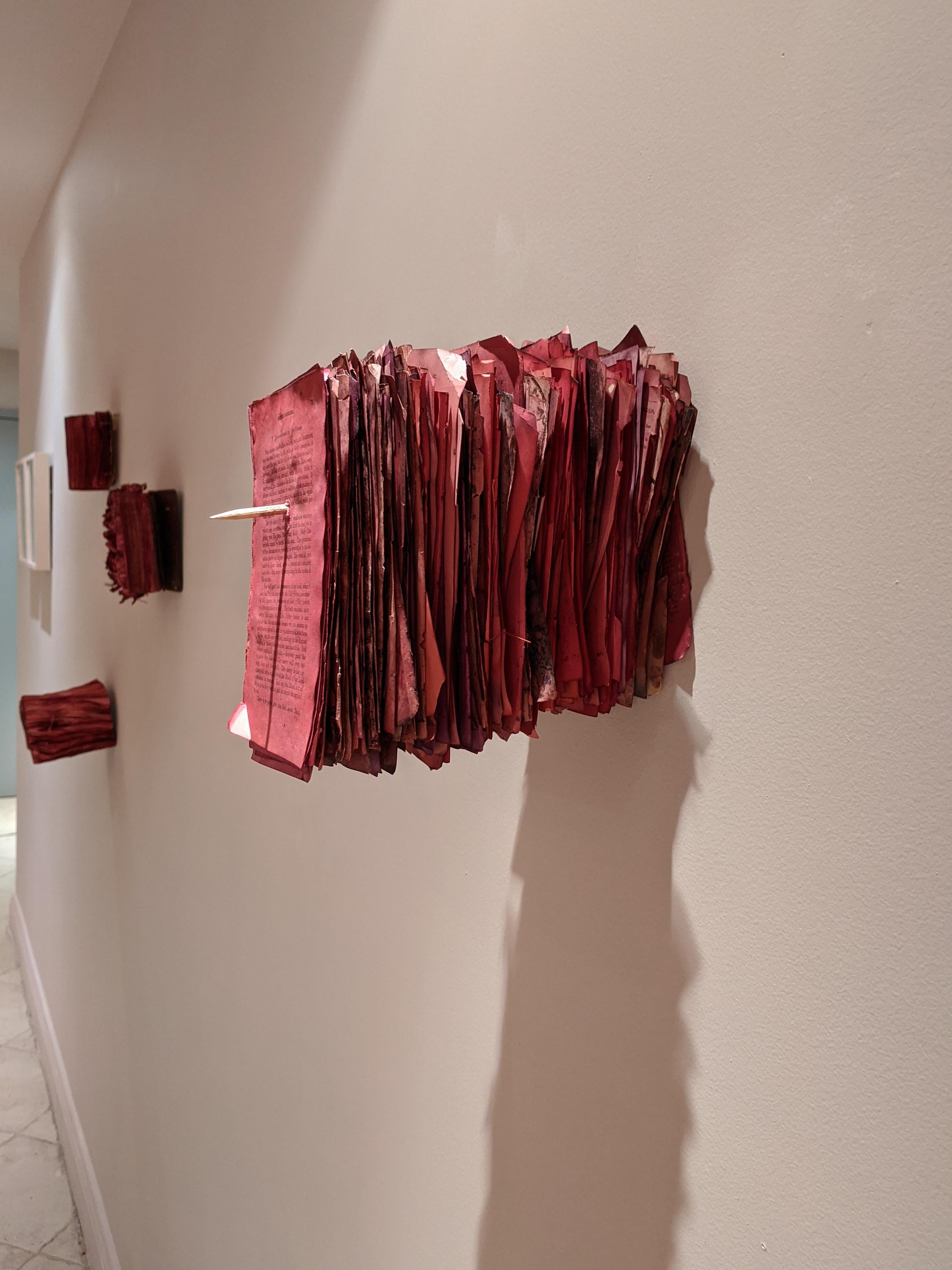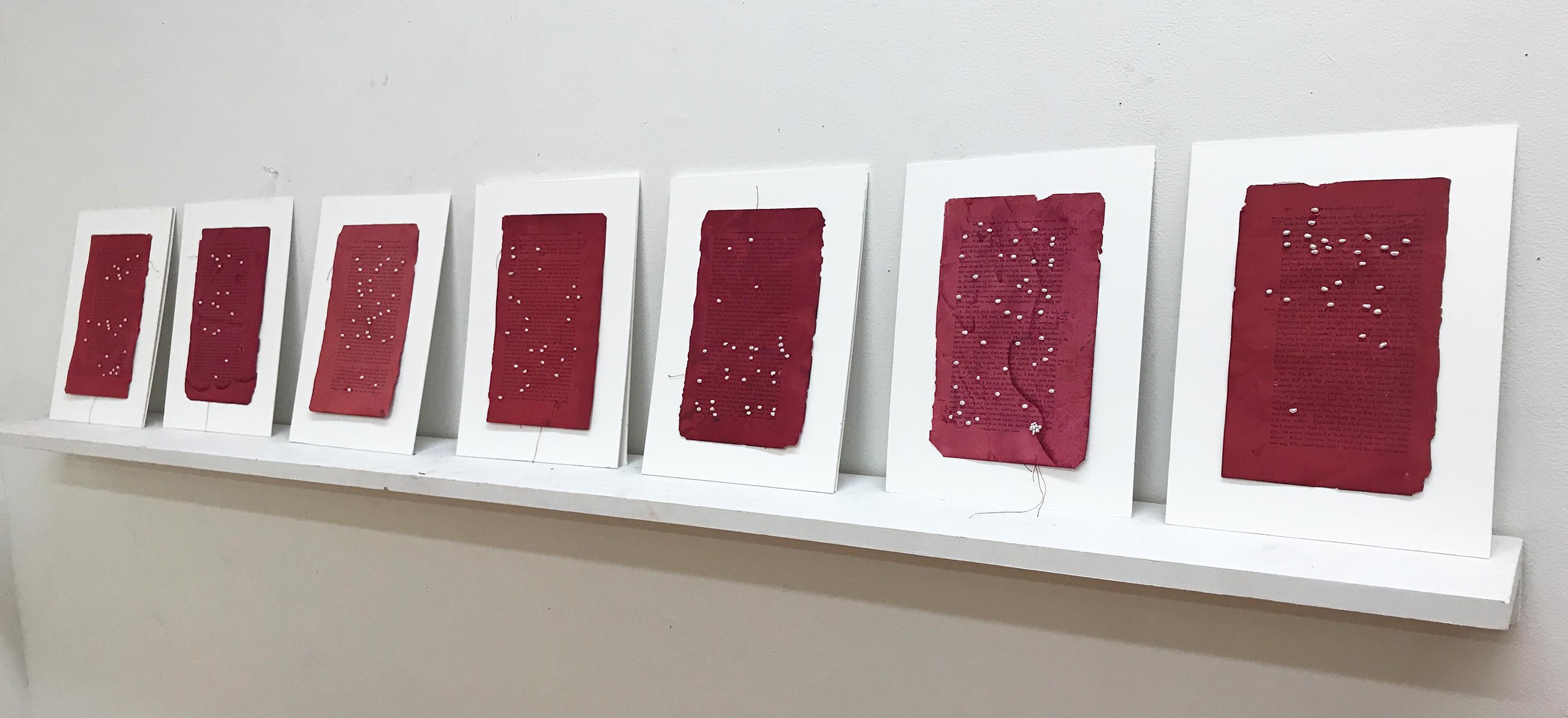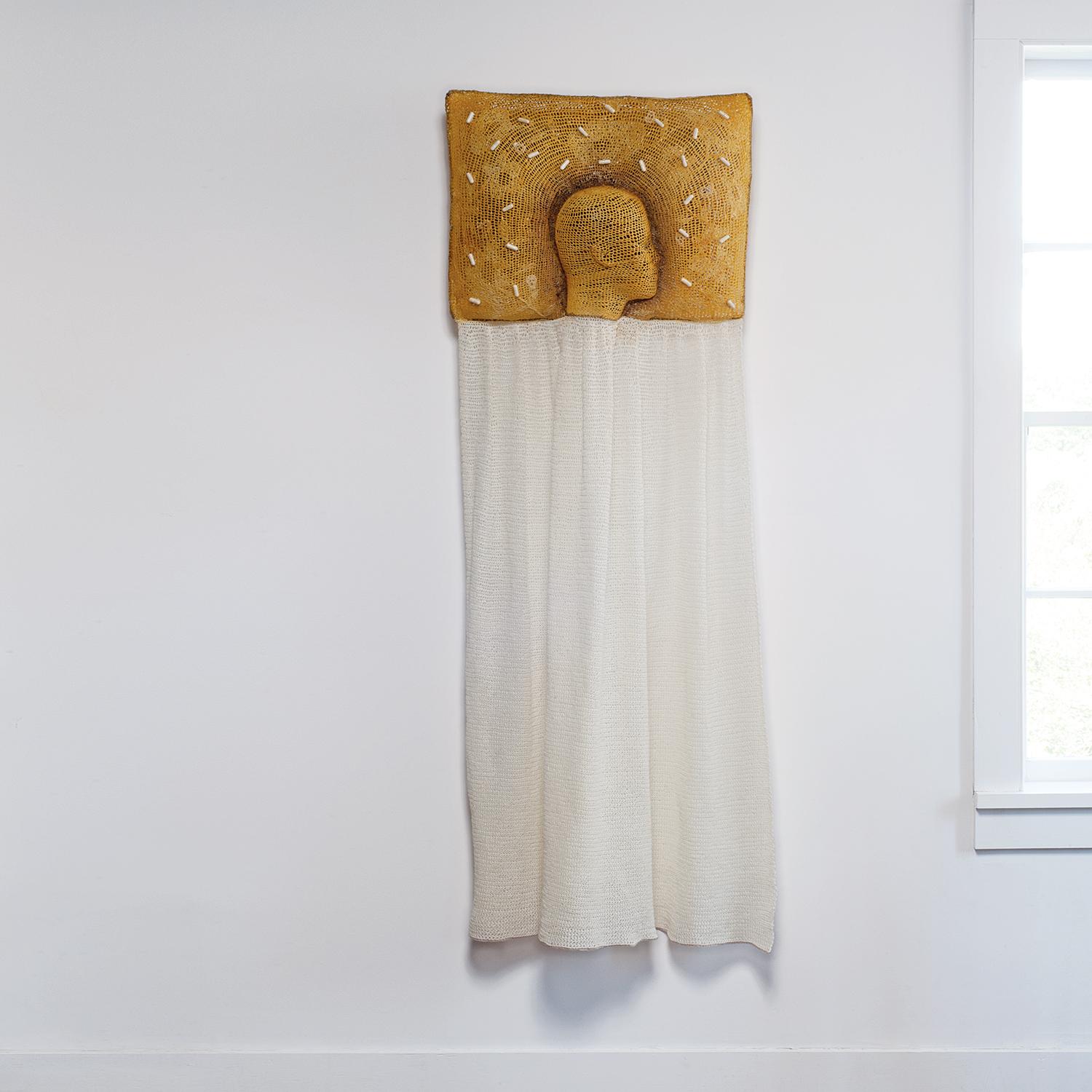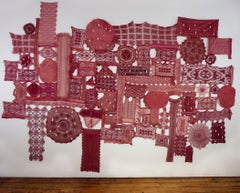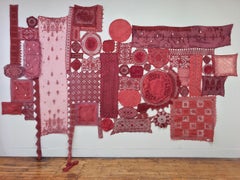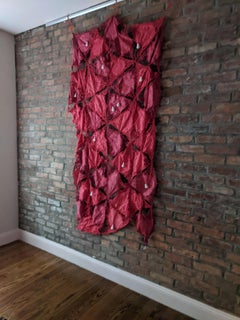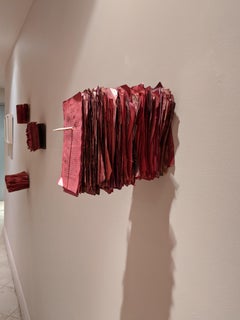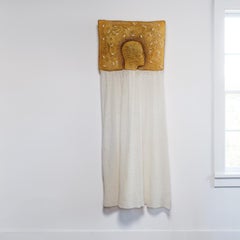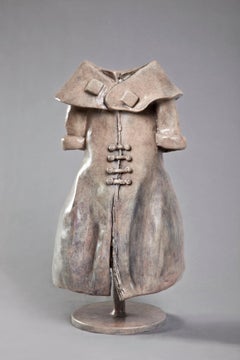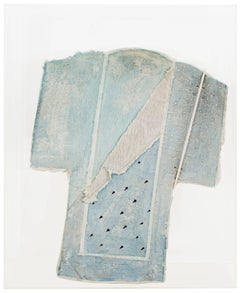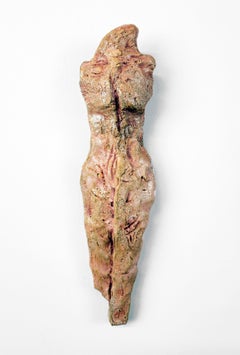Items Similar to Patricia Miranda, Dreaming Awake, 2020, nightdress, cochineal dyes, plaster,
Want more images or videos?
Request additional images or videos from the seller
1 of 4
Patricia MirandaPatricia Miranda, Dreaming Awake, 2020, nightdress, cochineal dyes, plaster,2020
2020
$5,000
£3,817.48
€4,411.06
CA$7,019.05
A$7,823.47
CHF 4,104.70
MX$95,537.28
NOK 51,974.48
SEK 49,123.79
DKK 32,921.67
About the Item
Patricia Miranda's work includes interdisciplinary installation, textile, paper and books. The textiles incorporated in these new pieces are vintage linens from her Italian and Irish grandmothers and sourced from friends and strangers around the country. Each donation is documented and integrated into the work. Textile as a form that wraps the body from cradle to grave. The role of lacemaking in the lives of women both economically and historically is packed with metaphorical potential. The relationship of craft and women’s work (re)appropriated by artists today to environmental and social issues is integral to the artist's research.
Her work is process oriented; materials are submerged in natural dyes from oak gall wasp nests, cochineal insects, turmeric, indigo, and clay. She forages for raw materials, cook dyes, grind pigments, ecofeminist actions that consider environmental impacts of objects. The process is left visible as dyestuff is unfiltered in the vat and finished work. Sewn into larger works, Miranda incorporates hair, pearls, bone beads, Milagros, cast plaster. The distinct genetics and environmental and cultural history of each material asserts its voice as collaborator rather than medium.
The lace inserts a visceral femininity into the pristine gallery, and exerts a ghostly trace of the history of domestic labor. The combination of earth and lace references human and environmental devastation and the conflation of nature and women’s bodies as justifications for exploitation. Mournful and solastalgic, they are lamentations to the violence against women and the earth.
Patricia Miranda is an interdisciplinary artist, curator, educator, and founder of The Crit Lab, graduate-level critique seminars and Residency for artists, and MAPSpace project space. She has been Visiting Artist at Vermont Studio Center, the Heckscher Museum, and University of Utah; and been awarded residencies at I-Park, Weir Farm, Vermont Studio Center, and Julio Valdez Printmaking Studio.
She received an Anonymous Was a Woman Covid19 Artist Relief Grant, an artist grant from ArtsWestchester/New York State Council on the Arts, and was part of a year-long NEA grant working with homeless youth.
Miranda currently teaches graduate curatorial studies at Western Colorado University, and develops programs for K-12, museums, and institutions such as Franklin Furnace.
Her work has been exhibited at ODETTA, NYC; ABC No Rio, NYC; Alexey von Schlippe Gallery at UConn, Groton, CT; Wave Hill, Bronx, NY; the Cape Museum of Fine Art, MA; the Belvedere Museum, Vienna, Austria.
- Creator:
- Creation Year:2020
- Dimensions:Height: 43 in (109.22 cm)Width: 30 in (76.2 cm)Depth: 10 in (25.4 cm)
- Medium:
- Movement & Style:
- Period:
- Condition:this work of art should be installed by a professional art handler. The artist is available to advise or install the project for an additional fee. Contact the gallery for more information.
- Gallery Location:Darien, CT
- Reference Number:1stDibs: LU17226667102
About the Seller
5.0
Vetted Professional Seller
Every seller passes strict standards for authenticity and reliability
Established in 2014
1stDibs seller since 2015
143 sales on 1stDibs
Typical response time: 6 hours
- ShippingRetrieving quote...Shipping from: Darien, CT
- Return Policy
Authenticity Guarantee
In the unlikely event there’s an issue with an item’s authenticity, contact us within 1 year for a full refund. DetailsMoney-Back Guarantee
If your item is not as described, is damaged in transit, or does not arrive, contact us within 7 days for a full refund. Details24-Hour Cancellation
You have a 24-hour grace period in which to reconsider your purchase, with no questions asked.Vetted Professional Sellers
Our world-class sellers must adhere to strict standards for service and quality, maintaining the integrity of our listings.Price-Match Guarantee
If you find that a seller listed the same item for a lower price elsewhere, we’ll match it.Trusted Global Delivery
Our best-in-class carrier network provides specialized shipping options worldwide, including custom delivery.More From This Seller
View AllPatricia Miranda, Lamentations for Ermenegilda; 2020, lace, cochineal dye, thread
By Patricia Miranda
Located in Darien, CT
Patricia Miranda's work includes interdisciplinary installation, textile, paper and books. The textiles incorporated in these new pieces are vintage linens from her Italian and Irish grandmothers and sourced from friends and strangers around the country. Each donation is documented and integrated into the work. Textile as a form that wraps the body from cradle to grave. The role of lacemaking in the lives of women both economically and historically is packed with metaphorical potential. The relationship of craft and women’s work (re)appropriated by artists today to environmental and social issues is integral to the artist's research.
Her work is process oriented; materials are submerged in natural dyes from oak gall wasp nests, cochineal insects, turmeric, indigo, and clay. She forages for raw materials, cook dyes, grind pigments, ecofeminist actions that consider environmental impacts of objects. The process is left visible as dyestuff is unfiltered in the vat and finished work. Sewn into larger works, Miranda incorporates hair, pearls, bone beads, Milagros, cast plaster. The distinct genetics and environmental and cultural history of each material asserts its voice as collaborator rather than medium.
The lace inserts a visceral femininity into the pristine gallery, and exerts a ghostly trace of the history of domestic labor. The combination of earth and lace references human and environmental devastation and the conflation of nature and women’s bodies as justifications for exploitation. Mournful and solastalgic, they are lamentations to the violence against women and the earth.
Patricia Miranda is an interdisciplinary artist, curator, educator, and founder of The Crit Lab, graduate-level critique seminars and Residency for artists, and MAPSpace project space. She has been Visiting Artist at Vermont Studio Center, the Heckscher Museum, and University of Utah; and been awarded residencies at I-Park, Weir Farm, Vermont Studio Center, and Julio Valdez Printmaking Studio.
She received an Anonymous Was a Woman Covid19 Artist Relief Grant, an artist grant from ArtsWestchester/New York State Council on the Arts, and was part of a year-long NEA grant working with homeless youth.
Miranda currently teaches graduate curatorial studies at Western Colorado University, and develops programs for K-12, museums, and institutions such as Franklin Furnace.
Her work has been exhibited at ODETTA, NYC; ABC No Rio, NYC; Alexey von...
Category
2010s Feminist Abstract Sculptures
Materials
Ceramic, Fabric, Thread, Dye, Found Objects
Patricia Miranda, Lamentations for Rebecca; 2020, lace, cochineal dye, thread
By Patricia Miranda
Located in Darien, CT
Patricia Miranda's work includes interdisciplinary installation, textile, paper and books. The textiles incorporated in these new pieces are vintage linens from her Italian and Irish grandmothers and sourced from friends and strangers around the country. Each donation is documented and integrated into the work. Textile as a form that wraps the body from cradle to grave. The role of lacemaking in the lives of women both economically and historically is packed with metaphorical potential. The relationship of craft and women’s work (re)appropriated by artists today to environmental and social issues is integral to the artist's research.
Her work is process oriented; materials are submerged in natural dyes from oak gall wasp nests, cochineal insects, turmeric, indigo, and clay. She forages for raw materials, cook dyes, grind pigments, ecofeminist actions that consider environmental impacts of objects. The process is left visible as dyestuff is unfiltered in the vat and finished work. Sewn into larger works, Miranda incorporates hair, pearls, bone beads, Milagros, cast plaster. The distinct genetics and environmental and cultural history of each material asserts its voice as collaborator rather than medium.
The lace inserts a visceral femininity into the pristine gallery, and exerts a ghostly trace of the history of domestic labor. The combination of earth and lace references human and environmental devastation and the conflation of nature and women’s bodies as justifications for exploitation. Mournful and solastalgic, they are lamentations to the violence against women and the earth.
Patricia Miranda is an interdisciplinary artist, curator, educator, and founder of The Crit Lab, graduate-level critique seminars and Residency for artists, and MAPSpace project space. She has been Visiting Artist at Vermont Studio Center, the Heckscher Museum, and University of Utah; and been awarded residencies at I-Park, Weir Farm, Vermont Studio Center, and Julio Valdez Printmaking Studio.
She received an Anonymous Was a Woman Covid19 Artist Relief Grant, an artist grant from ArtsWestchester/New York State Council on the Arts, and was part of a year-long NEA grant working with homeless youth.
Miranda currently teaches graduate curatorial studies at Western Colorado University, and develops programs for K-12, museums, and institutions such as Franklin Furnace.
Her work has been exhibited at ODETTA, NYC; ABC No Rio, NYC; Alexey von...
Category
2010s Feminist Abstract Sculptures
Materials
Ceramic, Fabric, Thread, Dye, Found Objects
Patricia Miranda, Sentinella, 2020, Battinger lace, synthetic dyes, cast plaster
By Patricia Miranda
Located in Darien, CT
Patricia Miranda's work includes interdisciplinary installation, textile, paper and books. The textiles incorporated in these new pieces are vintage linens from her Italian and Irish grandmothers and sourced from friends and strangers around the country. Each donation is documented and integrated into the work. Textile as a form that wraps the body from cradle to grave. The role of lacemaking in the lives of women both economically and historically is packed with metaphorical potential. The relationship of craft and women’s work (re)appropriated by artists today to environmental and social issues is integral to the artist's research.
Her work is process oriented; materials are submerged in natural dyes from oak gall wasp nests, cochineal insects, turmeric, indigo, and clay. She forages for raw materials, cook dyes, grind pigments, ecofeminist actions that consider environmental impacts of objects. The process is left visible as dyestuff is unfiltered in the vat and finished work. Sewn into larger works, Miranda incorporates hair, pearls, bone beads, Milagros, cast plaster. The distinct genetics and environmental and cultural history of each material asserts its voice as collaborator rather than medium.
The lace inserts a visceral femininity into the pristine gallery, and exerts a ghostly trace of the history of domestic labor. The combination of earth and lace references human and environmental devastation and the conflation of nature and women’s bodies as justifications for exploitation. Mournful and solastalgic, they are lamentations to the violence against women and the earth.
Patricia Miranda is an interdisciplinary artist, curator, educator, and founder of The Crit Lab, graduate-level critique seminars and Residency for artists, and MAPSpace project space. She has been Visiting Artist at Vermont Studio Center, the Heckscher Museum, and University of Utah; and been awarded residencies at I-Park, Weir Farm, Vermont Studio Center, and Julio Valdez Printmaking Studio.
She received an Anonymous Was a Woman Covid19 Artist Relief Grant, an artist grant from ArtsWestchester/New York State Council on the Arts, and was part of a year-long NEA grant working with homeless youth.
Miranda currently teaches graduate curatorial studies at Western Colorado University, and develops programs for K-12, museums, and institutions such as Franklin Furnace.
Her work has been exhibited at ODETTA, NYC; ABC No Rio, NYC; Alexey von...
Category
2010s Feminist Abstract Sculptures
Materials
Fabric, Dye, Plastic
Patricia Miranda, Florilegium Series, 2016, cochineal dyes, antique books, pearl
By Patricia Miranda
Located in Darien, CT
Patricia Miranda's work includes interdisciplinary installation, textile, paper and books. The textiles incorporated in these new pieces are vintage linens from her Italian and Irish grandmothers and sourced from friends and strangers around the country. Each donation is documented and integrated into the work. Textile as a form that wraps the body from cradle to grave. The role of lacemaking in the lives of women both economically and historically is packed with metaphorical potential. The relationship of craft and women’s work (re)appropriated by artists today to environmental and social issues is integral to the artist's research.
Her work is process oriented; materials are submerged in natural dyes from oak gall wasp nests, cochineal insects, turmeric, indigo, and clay. She forages for raw materials, cook dyes, grind pigments, ecofeminist actions that consider environmental impacts of objects. The process is left visible as dyestuff is unfiltered in the vat and finished work. Sewn into larger works, Miranda incorporates hair, pearls, bone beads, Milagros, cast plaster. The distinct genetics and environmental and cultural history of each material asserts its voice as collaborator rather than medium.
The lace inserts a visceral femininity into the pristine gallery, and exerts a ghostly trace of the history of domestic labor. The combination of earth and lace references human and environmental devastation and the conflation of nature and women’s bodies as justifications for exploitation. Mournful and solastalgic, they are lamentations to the violence against women and the earth.
Patricia Miranda is an interdisciplinary artist, curator, educator, and founder of The Crit Lab, graduate-level critique seminars and Residency for artists, and MAPSpace project space. She has been Visiting Artist at Vermont Studio Center, the Heckscher Museum, and University of Utah; and been awarded residencies at I-Park, Weir Farm, Vermont Studio Center, and Julio Valdez Printmaking Studio.
She received an Anonymous Was a Woman Covid19 Artist Relief Grant, an artist grant from ArtsWestchester/New York State Council on the Arts, and was part of a year-long NEA grant working with homeless youth.
Miranda currently teaches graduate curatorial studies at Western Colorado University, and develops programs for K-12, museums, and institutions such as Franklin Furnace.
Her work has been exhibited at ODETTA, NYC; ABC No Rio, NYC; Alexey von...
Category
2010s Feminist Abstract Sculptures
Materials
Fabric, Thread, Plaster, Dye, Found Objects
Patricia Miranda, Pearls Before Swine 2020, cochineal dyes, pages, sewn pearls
By Patricia Miranda
Located in Darien, CT
Patricia Miranda's work includes interdisciplinary installation, textile, paper and books. The textiles incorporated in these new pieces are vintage linens from her Italian and Irish grandmothers and sourced from friends and strangers around the country. Each donation is documented and integrated into the work. Textile as a form that wraps the body from cradle to grave. The role of lacemaking in the lives of women both economically and historically is packed with metaphorical potential. The relationship of craft and women’s work (re)appropriated by artists today to environmental and social issues is integral to the artist's research.
Her work is process oriented; materials are submerged in natural dyes from oak gall wasp nests, cochineal insects, turmeric, indigo, and clay. She forages for raw materials, cook dyes, grind pigments, ecofeminist actions that consider environmental impacts of objects. The process is left visible as dyestuff is unfiltered in the vat and finished work. Sewn into larger works, Miranda incorporates hair, pearls, bone beads, Milagros, cast plaster. The distinct genetics and environmental and cultural history of each material asserts its voice as collaborator rather than medium.
The lace inserts a visceral femininity into the pristine gallery, and exerts a ghostly trace of the history of domestic labor. The combination of earth and lace references human and environmental devastation and the conflation of nature and women’s bodies as justifications for exploitation. Mournful and solastalgic, they are lamentations to the violence against women and the earth.
Patricia Miranda is an interdisciplinary artist, curator, educator, and founder of The Crit Lab, graduate-level critique seminars and Residency for artists, and MAPSpace project space. She has been Visiting Artist at Vermont Studio Center, the Heckscher Museum, and University of Utah; and been awarded residencies at I-Park, Weir Farm, Vermont Studio Center, and Julio Valdez Printmaking Studio.
She received an Anonymous Was a Woman Covid19 Artist Relief Grant, an artist grant from ArtsWestchester/New York State Council on the Arts, and was part of a year-long NEA grant working with homeless youth.
Miranda currently teaches graduate curatorial studies at Western Colorado University, and develops programs for K-12, museums, and institutions such as Franklin Furnace.
Her work has been exhibited at ODETTA, NYC; ABC No Rio, NYC; Alexey von...
Category
2010s Feminist Abstract Sculptures
Materials
Thread, Dye, Found Objects
Patricia Miranda, Florilegium Series, 2016, cochineal dyes, antique books, pearl
By Patricia Miranda
Located in Darien, CT
Patricia Miranda's work includes interdisciplinary installation, textile, paper and books. The textiles incorporated in these new pieces are vintage linens from her Italian and Irish grandmothers and sourced from friends and strangers around the country. Each donation is documented and integrated into the work. Textile as a form that wraps the body from cradle to grave. The role of lacemaking in the lives of women both economically and historically is packed with metaphorical potential. The relationship of craft and women’s work (re)appropriated by artists today to environmental and social issues is integral to the artist's research.
Her work is process oriented; materials are submerged in natural dyes from oak gall wasp nests, cochineal insects, turmeric, indigo, and clay. She forages for raw materials, cook dyes, grind pigments, ecofeminist actions that consider environmental impacts of objects. The process is left visible as dyestuff is unfiltered in the vat and finished work. Sewn into larger works, Miranda incorporates hair, pearls, bone beads, Milagros, cast plaster. The distinct genetics and environmental and cultural history of each material asserts its voice as collaborator rather than medium.
The lace inserts a visceral femininity into the pristine gallery, and exerts a ghostly trace of the history of domestic labor. The combination of earth and lace references human and environmental devastation and the conflation of nature and women’s bodies as justifications for exploitation. Mournful and solastalgic, they are lamentations to the violence against women and the earth.
Patricia Miranda is an interdisciplinary artist, curator, educator, and founder of The Crit Lab, graduate-level critique seminars and Residency for artists, and MAPSpace project space. She has been Visiting Artist at Vermont Studio Center, the Heckscher Museum, and University of Utah; and been awarded residencies at I-Park, Weir Farm, Vermont Studio Center, and Julio Valdez Printmaking Studio.
She received an Anonymous Was a Woman Covid19 Artist Relief Grant, an artist grant from ArtsWestchester/New York State Council on the Arts, and was part of a year-long NEA grant working with homeless youth.
Miranda currently teaches graduate curatorial studies at Western Colorado University, and develops programs for K-12, museums, and institutions such as Franklin Furnace.
Her work has been exhibited at ODETTA, NYC; ABC No Rio, NYC; Alexey von...
Category
2010s Feminist Abstract Sculptures
Materials
Fabric, Thread, Plaster, Dye, Found Objects
You May Also Like
"Sweet Dreams" contemporary mixed media textile wall sculpture
By Norma Minkowitz
Located in Wilton, CT
"Sweet Dreams" mixed media, 68 1/2 x 24 1/4 x 8, 2012.
This mixed media textile wall sculpture was done by American fiber artist, Norma Minkowitz (b....
Category
2010s Contemporary Figurative Sculptures
Materials
Textile, Thread, Mixed Media, Fabric
Anita Birkenfeld, Dress, garment sculpture, Bronze sculpture
By Anita Birkenfeld
Located in Tel Aviv, IL
Anita Birkenfeld, Bronze sculpture, figurative sculpture, soul, Garment, Israeli art, Israeli artist
Category
2010s Symbolist Figurative Sculptures
Materials
Bronze
"Blue Robe, Purple Tears II, " Porcelain by Marjorie Mau
By Marjorie Mau
Located in Milwaukee, WI
"Blue Robe, Purple Tears II" is an original porcelain and ink piece by Marjorie Mau. The artist signed the sculpture.
18" x 13" x 3" art
Artist's Statement...
Category
1980s Sculptures
Materials
Porcelain, Archival Ink, Mixed Media
American Contemporary Ceramic Sculpture - Linda Stein, Rose Knight 238
Located in New York, NY
This sculpture from Linda Stein’s Knights of Protection series functions both as a defender in battle and a symbol of pacifism.
Stein's works are in mor...
Category
2010s Contemporary Abstract Sculptures
Materials
Ceramic
$2,000 Sale Price
20% Off
'Camile' Mixed Media, Found Object Sculpture of a Red and Orange Dress
By John Petrey
Located in Rye, NY
The sculpture, "Camile", is an artistic take on the 1960's shirtwaist dress and is made from enamel painted aluminum with a red bottle cap bodice. Dimensions are 26" T x 16" W x 16...
Category
2010s Contemporary Figurative Sculptures
Materials
Enamel
The Disremembered II
By Esperanza Cortes
Located in New Orleans, LA
The artist says of her work...
Arrested Symphony is an exhibition incorporating sculptures, reliefs, drawings and hanging works that explore the theme of injustice that is at the roots of the predatory gem and mineral excavation industry. While at a residency in Knoxville, Tennessee, I discovered that Oakridge was only 30 miles away. Oakridge played a key role in the development of the Atom Bomb and the Manhattan Project. I began an exploration and comparison of Uranium and Emeralds. These minerals look very much alike, beautiful but dangerous on their effect on civil conflict. Colombia my birthplace, has the finest Emeralds in the world. The mining of Emeralds was an important element in the continued colonization of the region. Emeralds have helped to fund the more than 60-year conflict which has taken over 450,000 lives and displaced about 5.7 million people. Uranium has brought destruction to a level which altered the future of warfare. The developments made during the Manhattan Project led to the death of about 700,000 people and its effects are still felt around the world. I use Colombia as an example, however this situation is repeating itself in many parts of the world. Sierra Leone, Liberia, the Republic of Congo, the Central African Republic and the Democratic Republic of Congo are all involved in brutal civil conflicts fueled by Blood Diamonds. This project will make visual the human cost extracted with these minerals, once exposed to the light of day they can never be unearthed.
My practice is an ongoing object-based exploration through which I create artworks which are organic and improvisational constructions that are infused with hope and renewal. The hand-crafted artworks are poetically and intricately crafted, creating an intimate repository for the individual and collective memory and implement the human body as a symbol and expression of nature, vulnerability and power. The work encourages viewers to reconsider social and historical narratives especially when dealing with the aftermath of Colonialism and raises critical questions about the politics of erasure and exclusion.
ESPERANZA CORTÉS is a Colombian born contemporary multidisciplinary artist based in New York City. Cortés has exhibited in the United States in solo and group exhibitions in venues including Smack Mellon Gallery, Neuberger Museum of Art, Bronx Museum of Art, Queens Museum, El Museo Del Barrio, MoMA PS1, Socrates Sculpture Park and White-box Gallery in New York City. Nationally Cortes exhibitions include Cleveland Art Museum, OH, CSU Galleries at Cleveland University, OH, Helen Day Art Center, VT and The Lorenzo Homar...
Category
21st Century and Contemporary Contemporary Figurative Sculptures
Materials
Metal
More Ways To Browse
Cast Plaster Sculpture
Plaster Art Casts
Large Plaster Sculpture
Plaster Woman Sculpture
Bone Beads
Large Plaster Relief
Italian Plaster Relief
Andy Warhol Chanel
Antique Advertising Bicycles
Chinese Tiger Painting
Dior 2004 Shoes
Dune Poster
Francisco Santana
Harold Garde
Hound Dog Framed Oil Painting
Isle Of Skye
Japanese Male Nude
Linen Backed Jazz Posters
